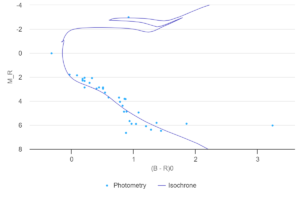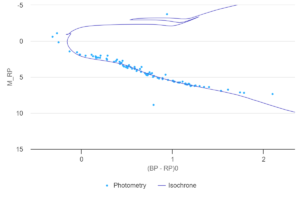NGC 2669 is a open star cluster in the Southern constellation Vela. It was discovered by John Herschel in 1834 at the Cape of Good Hope.
As discussed here, NGC 2669 can be seen with binoculars due to the fact it has a brighter magnitude of 6.1.
In order to study NGC 2669 and investigate the relationships between the colours, brightnesses, and the age and chemical composition of the cluster as a whole, I collected 15 images in these filters with certain telescopes, with total exposure durations of 17.74s, 33.87s and 50s in these filters for R, V, and B respectively, with other imaging parameters, using Skynet. I used Afterglow and Cluster Astromancer for their purposes. And I found these basic results about distance, proper motion, etc.
The radius of the cluster ends up being 0.113017 (ly) across. This, in a slightly more relevant term, is just shy of 84 million Earths across. This cluster features 308 stars. The cluster is also 33 quadrillion kilometers away, or 47 billion suns away.
Here is the colour corrected image of NGC 2669

Here is the rest of the information in a more formal format obtained from here:
Right Ascension: 131.59°
Declination: -52.94°
Galactic Longitude: 270.838°
Galactic Latitude: -6.075°
Cluster radius: 0.113017 (ly)
Number of cluster stars: 308
Distance: 1.057 (kpc)
Reddening: 0.35 (mag)
Log of age: 8.35 log(yrs)
Metallicity: -0.55 (solar)
Class: OPEN STAR CLUSTER
Proper Motion in RA: -4.136 (mas/yr)
Proper Motion in Dec: 4.649 (mas/yr)
These are some graphs on the stars of NGC 2669, and how they are progressing along the life of a star.


As shown most stars featured in NGC 2669 are along the main sequence. The cluster is not home to many blue stragglers. The cluster is rather ‘tame’ unfortunately not boasting any large nebulas or appealing debris, but does feature some giants. With this cluster being ‘tame’ it had made it more uniform to analyze and obtain the information about it. One of the noticeable and recognizable features of NGC 2669 is the trapezoidal form of stars near the center of the cluster. Phil Harrington describes NGC 2669 nicely as “On its own, NGC 2669 is not especially impressive, but add to it the whole magnificent region and you have a ringside seat to a wonderful star-studded show for binoculars.”
Having completed by analysis, it is absolutely amazing the ability that we have as individuals to study the sky. We are able to observe several physical traits based on the shoulders of others. The work others have done for us is a massive help, but we can still study these features and see visuals of stars from the comfort of our offices and homes.
I’m sure I did not do this cluster its proper justice due to my inexperience of astronomy, but I hope people in the future will be able to succeed more than me. If I ever find myself stargazing, I’ll be looking for NGC 2669.